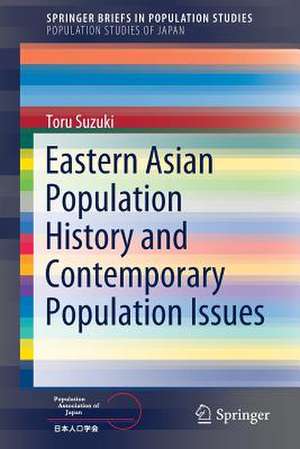Eastern Asian Population History and Contemporary Population Issues: SpringerBriefs in Population Studies
Autor Toru Suzukien Limba Engleză Paperback – 26 feb 2019
Din seria SpringerBriefs in Population Studies
-
 Preț: 344.90 lei
Preț: 344.90 lei -
 Preț: 177.49 lei
Preț: 177.49 lei -
 Preț: 355.54 lei
Preț: 355.54 lei -
 Preț: 317.11 lei
Preț: 317.11 lei -
 Preț: 442.62 lei
Preț: 442.62 lei - 15%
 Preț: 463.03 lei
Preț: 463.03 lei - 15%
 Preț: 463.68 lei
Preț: 463.68 lei -
 Preț: 377.57 lei
Preț: 377.57 lei -
 Preț: 414.42 lei
Preț: 414.42 lei -
 Preț: 476.57 lei
Preț: 476.57 lei -
 Preț: 376.80 lei
Preț: 376.80 lei -
 Preț: 376.22 lei
Preț: 376.22 lei -
 Preț: 377.73 lei
Preț: 377.73 lei -
 Preț: 477.17 lei
Preț: 477.17 lei -
 Preț: 379.09 lei
Preț: 379.09 lei -
 Preț: 346.66 lei
Preț: 346.66 lei -
 Preț: 380.07 lei
Preț: 380.07 lei -
 Preț: 343.88 lei
Preț: 343.88 lei -
 Preț: 374.46 lei
Preț: 374.46 lei -
 Preț: 343.39 lei
Preț: 343.39 lei -
 Preț: 205.29 lei
Preț: 205.29 lei -
 Preț: 378.92 lei
Preț: 378.92 lei -
 Preț: 375.23 lei
Preț: 375.23 lei -
 Preț: 378.34 lei
Preț: 378.34 lei -
 Preț: 474.84 lei
Preț: 474.84 lei -
 Preț: 476.42 lei
Preț: 476.42 lei -
 Preț: 379.09 lei
Preț: 379.09 lei -
 Preț: 476.79 lei
Preț: 476.79 lei -
 Preț: 441.85 lei
Preț: 441.85 lei - 15%
 Preț: 461.73 lei
Preț: 461.73 lei -
 Preț: 375.23 lei
Preț: 375.23 lei -
 Preț: 259.96 lei
Preț: 259.96 lei -
 Preț: 343.88 lei
Preț: 343.88 lei -
 Preț: 442.62 lei
Preț: 442.62 lei -
 Preț: 474.67 lei
Preț: 474.67 lei -
 Preț: 443.75 lei
Preț: 443.75 lei -
 Preț: 443.00 lei
Preț: 443.00 lei -
 Preț: 262.09 lei
Preț: 262.09 lei -
 Preț: 376.80 lei
Preț: 376.80 lei -
 Preț: 377.18 lei
Preț: 377.18 lei -
 Preț: 311.91 lei
Preț: 311.91 lei -
 Preț: 174.62 lei
Preț: 174.62 lei -
 Preț: 379.09 lei
Preț: 379.09 lei -
 Preț: 477.72 lei
Preț: 477.72 lei -
 Preț: 340.45 lei
Preț: 340.45 lei -
 Preț: 374.85 lei
Preț: 374.85 lei -
 Preț: 475.22 lei
Preț: 475.22 lei
Preț: 376.59 lei
Nou
Puncte Express: 565
Preț estimativ în valută:
72.08€ • 78.32$ • 60.59£
72.08€ • 78.32$ • 60.59£
Carte tipărită la comandă
Livrare economică 21 aprilie-05 mai
Preluare comenzi: 021 569.72.76
Specificații
ISBN-13: 9789811332296
ISBN-10: 9811332290
Pagini: 100
Ilustrații: X, 84 p. 14 illus., 13 illus. in color.
Dimensiuni: 155 x 235 mm
Greutate: 0.15 kg
Ediția:1st ed. 2019
Editura: Springer Nature Singapore
Colecția Springer
Seriile SpringerBriefs in Population Studies, Population Studies of Japan
Locul publicării:Singapore, Singapore
ISBN-10: 9811332290
Pagini: 100
Ilustrații: X, 84 p. 14 illus., 13 illus. in color.
Dimensiuni: 155 x 235 mm
Greutate: 0.15 kg
Ediția:1st ed. 2019
Editura: Springer Nature Singapore
Colecția Springer
Seriile SpringerBriefs in Population Studies, Population Studies of Japan
Locul publicării:Singapore, Singapore
Cuprins
1. Introduction.- 2. Peasant Society in Eastern Asia.- 3. Fertility Decline and Cultural
Pattern.- 4.Population Growth and Economic Growth.- 5. Domestic and International
Migrations.- 6. Conclusion.
Notă biografică
Toru Suzuki, National Institute of Population and Social Security Research
Caracteristici
Presents a comparative cultural view of family patterns in Eastern Asia based on historical and anthropological findings Makes thorough reference to Japanese, Korean, and Chinese literature on demographic and economic changes Promotes a fresh understanding of contemporary population issues from the long-term historical perspective
